Abstract
Facioscapulohumeral muscular dystrophy (FSHD) is a slowly progressive primary disease of muscle which is usually inherited as an autosomal dominant disorder. FSHD has been localized to the long arm of chromosome 4, specifically to the 4q3.5-qter region. Initially published linkage studies showed no evidence for heterogeneity in FSHD. In the present study we have examined individuals in seven FSHD families. Two-point lod scores show significant evidence for linkage for D4S163 (lod score 3.04 at recombination fraction .21) and D4S139 (lod score 3.84 at recombination fraction .20). D4S171 also gave a positive score (lod score 2.56 at recombination fraction .24). Significant evidence for heterogeneity was found for each of the three markers. Multipoint linkage analysis in this region resulted in a peak multipoint lod score of 6.47. The multipoint analysis supported the two-point studies with odds of 20:1 showing linkage and heterogeneity over linkage and homogeneity. Five of the seven families gave a posterior probability of >95% of being of the linked type, while two families appeared unlinked to this region of 4q (P < .01%). Individuals in the two unlinked families met the clinical criteria for the diagnosis of FSHD, including facial weakness, clavicular flattening, scapula winging, proximal muscle weakness, and myopathic changes on muscle biopsies without inflammatory or mitochondrial pathology. This study demonstrates genetic heterogeneity in FSHD and has important implications for both genetic counseling and the elucidation of the etiology of FSHD.
Full text
PDF
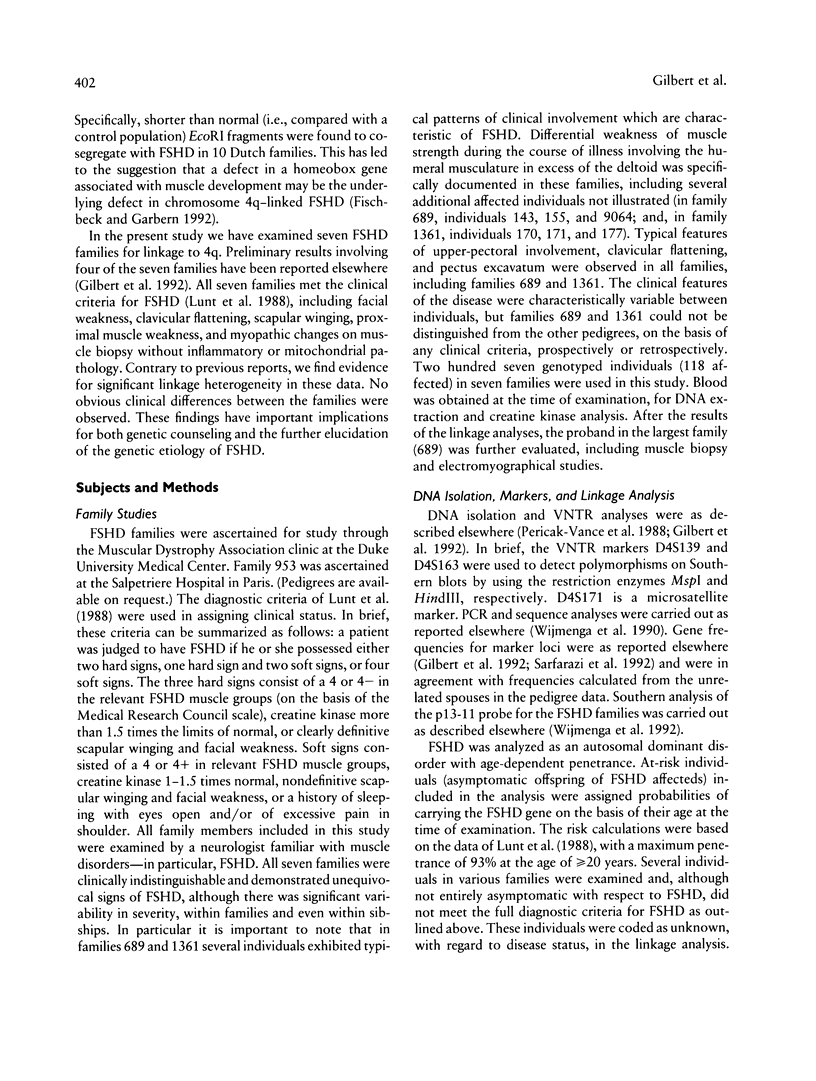
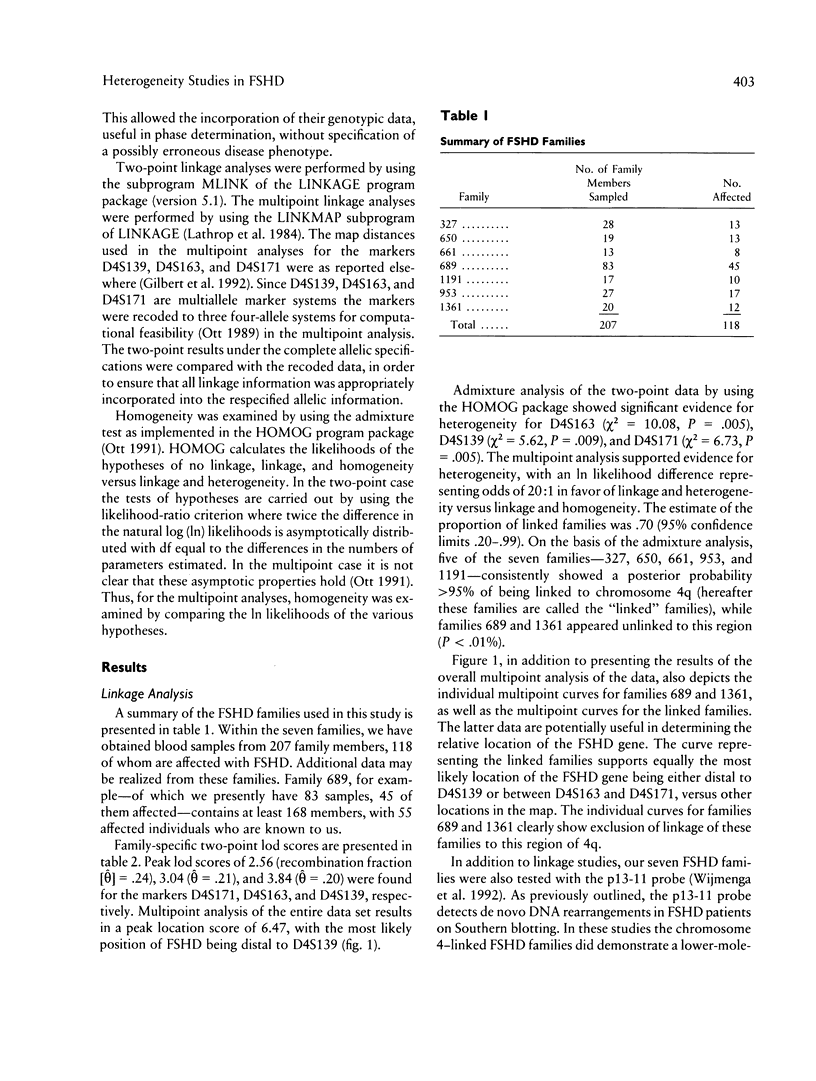
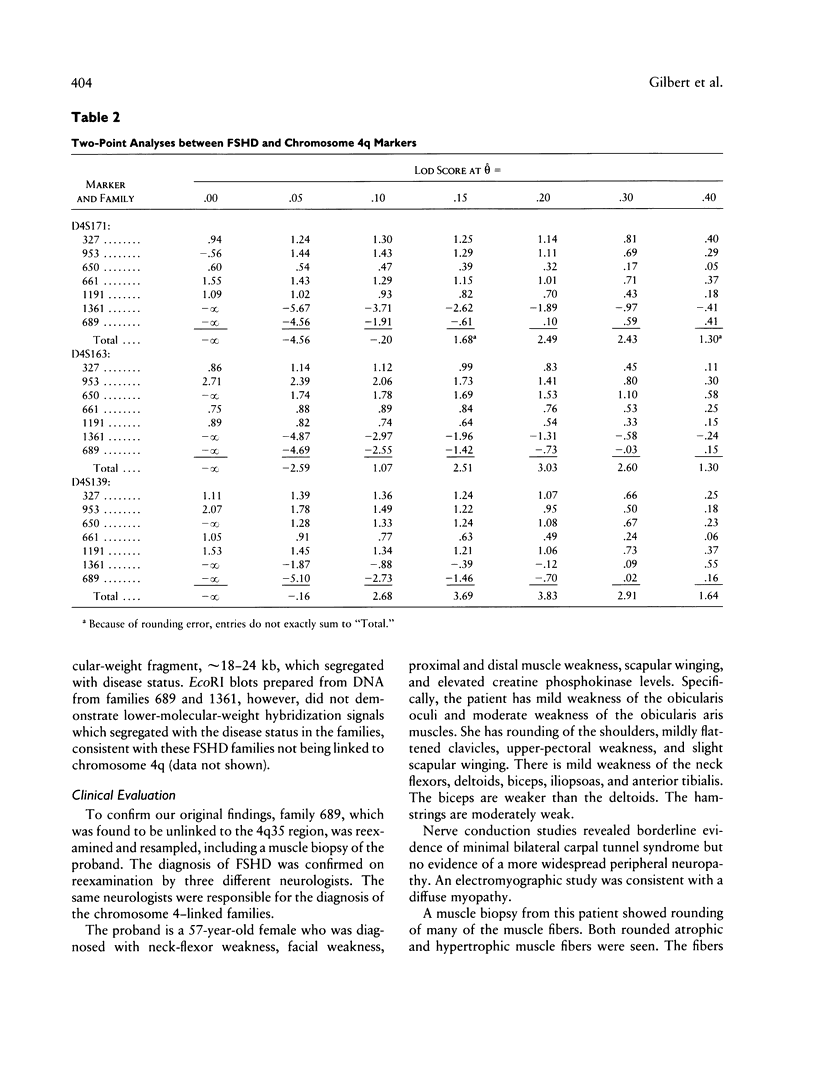
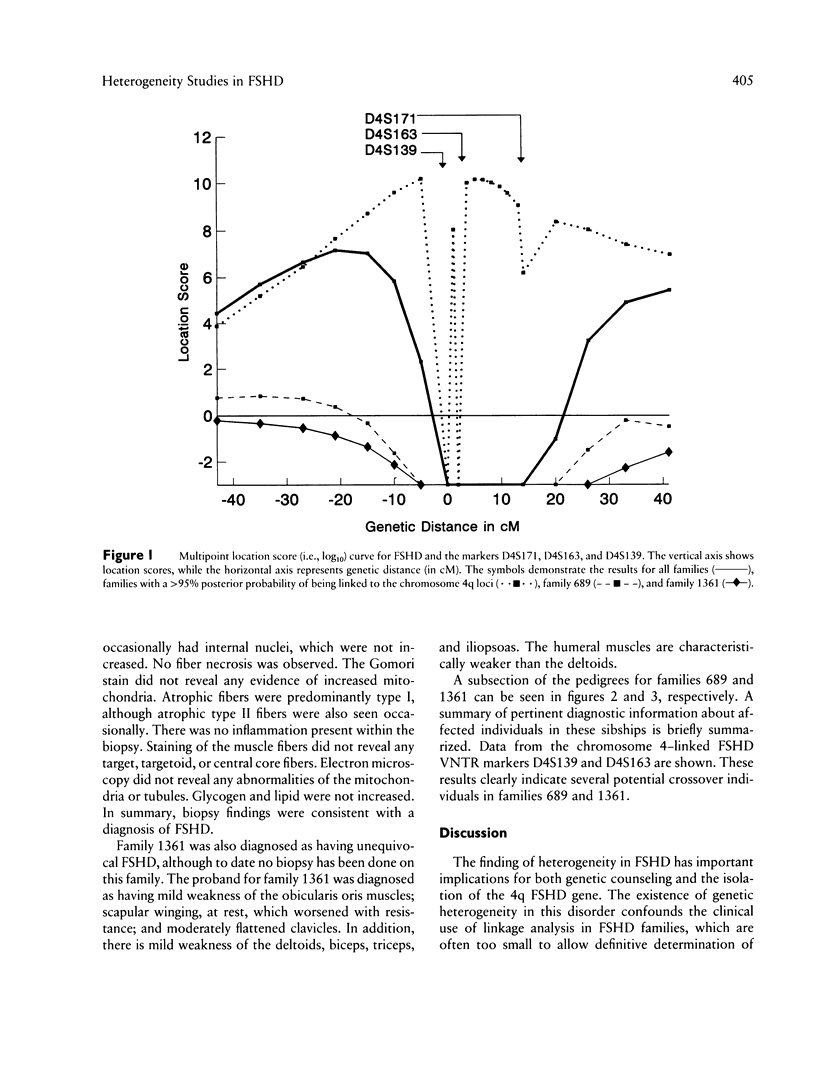
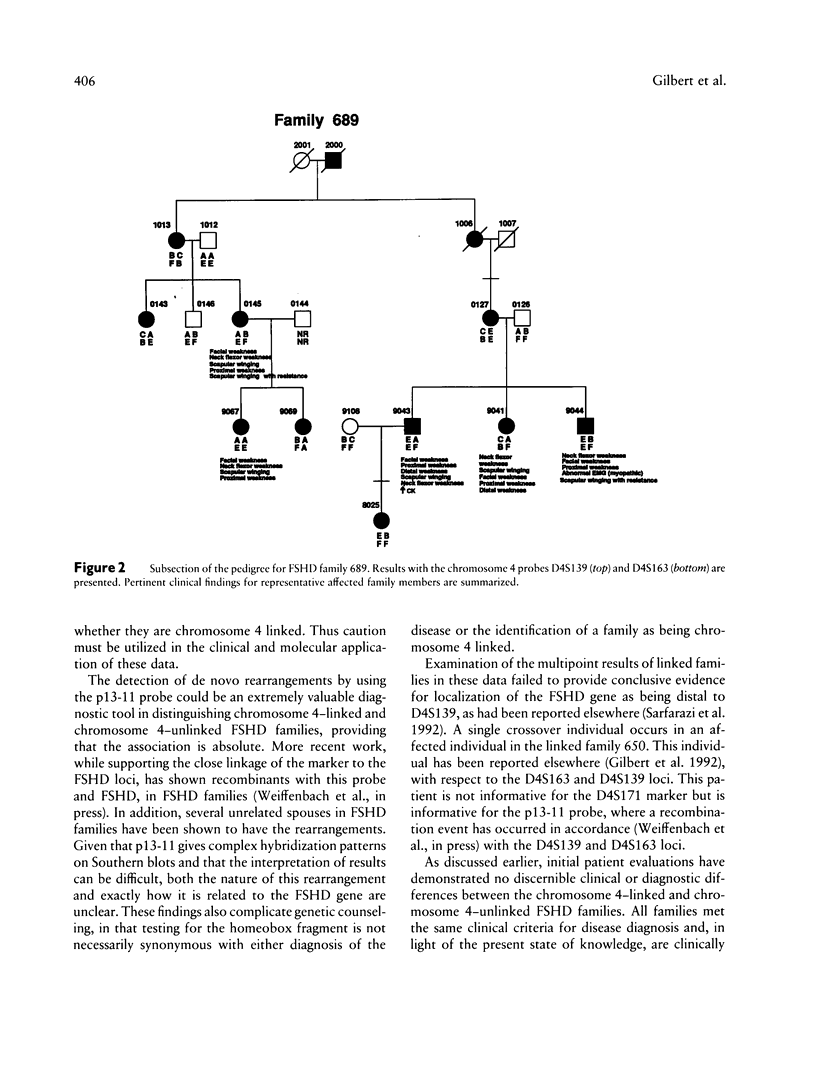

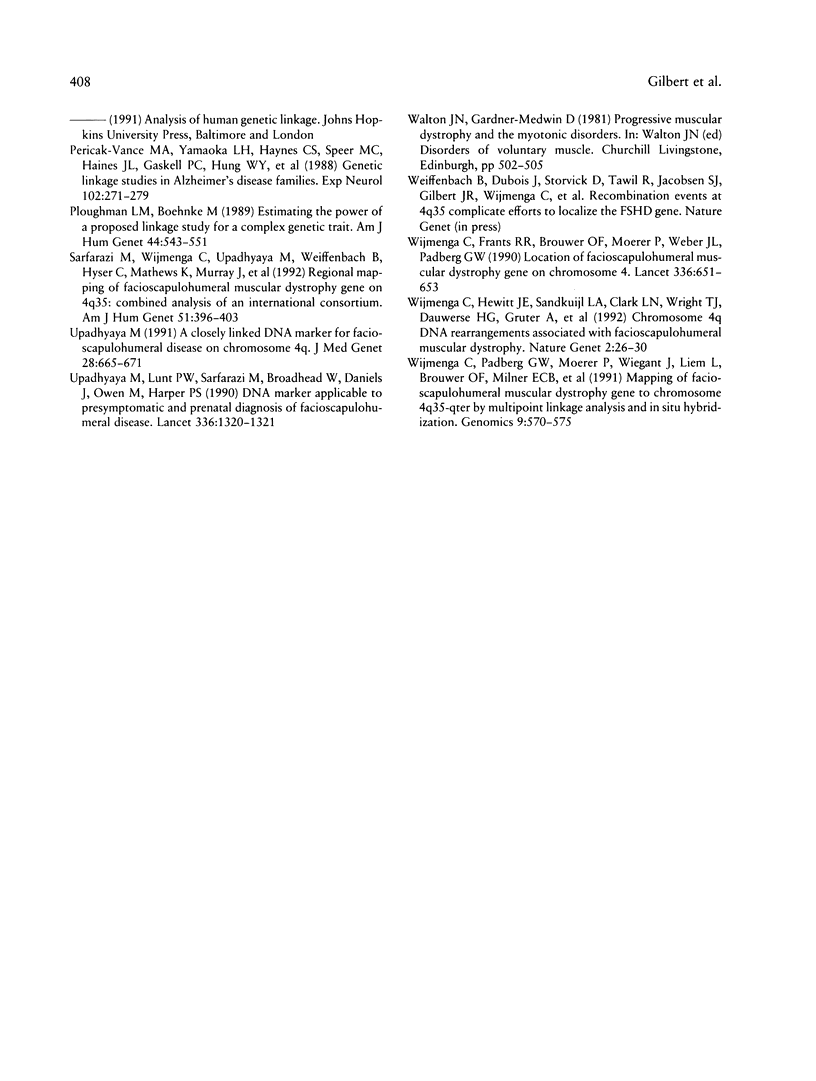
Selected References
These references are in PubMed. This may not be the complete list of references from this article.
- Fischbeck K. H., Garbern J. Y. Facioscapulohumeral muscular dystrophy defect identified. Nat Genet. 1992 Sep;2(1):3–4. doi: 10.1038/ng0992-3. [DOI] [PubMed] [Google Scholar]
- Gilbert J. R., Stajich J. M., Speer M. C., Vance J. M., Stewart C. S., Yamaoka L. H., Samson F., Fardeau M., Potter T. G., Roses A. D. Linkage studies in facioscapulohumeral muscular dystrophy (FSHD). Am J Hum Genet. 1992 Aug;51(2):424–427. [PMC free article] [PubMed] [Google Scholar]
- Lathrop G. M., Lalouel J. M., Julier C., Ott J. Strategies for multilocus linkage analysis in humans. Proc Natl Acad Sci U S A. 1984 Jun;81(11):3443–3446. doi: 10.1073/pnas.81.11.3443. [DOI] [PMC free article] [PubMed] [Google Scholar]
- Lunt P. W., Noades J. G., Upadhyaya M., Sarfarazi M., Harper P. S. Evidence against location of the gene for facioscapulohumeral muscular dystrophy on the distal long arm of chromosome 14. J Neurol Sci. 1988 Dec;88(1-3):287–292. doi: 10.1016/0022-510x(88)90225-0. [DOI] [PubMed] [Google Scholar]
- MORTON N. E., CHUNG C. S. Formal genetics of muscular dystrophy. Am J Hum Genet. 1959 Dec;11:360–379. [PMC free article] [PubMed] [Google Scholar]
- Moser H., Wiesmann U., Richterich R., Rossi E. Progressive Muskeldystrophie. 8. Häufigkeit, Klinik und Genetik der Typen I und II. Schweiz Med Wochenschr. 1966 Feb 12;96(6):169–contd. [PubMed] [Google Scholar]
- Pericak-Vance M. A., Yamaoka L. H., Haynes C. S., Speer M. C., Haines J. L., Gaskell P. C., Hung W. Y., Clark C. M., Heyman A. L., Trofatter J. A. Genetic linkage studies in Alzheimer's disease families. Exp Neurol. 1988 Dec;102(3):271–279. doi: 10.1016/0014-4886(88)90220-8. [DOI] [PubMed] [Google Scholar]
- Ploughman L. M., Boehnke M. Estimating the power of a proposed linkage study for a complex genetic trait. Am J Hum Genet. 1989 Apr;44(4):543–551. [PMC free article] [PubMed] [Google Scholar]
- Sarfarazi M., Wijmenga C., Upadhyaya M., Weiffenbach B., Hyser C., Mathews K., Murray J., Gilbert J., Pericak-Vance M., Lunt P. Regional mapping of facioscapulohumeral muscular dystrophy gene on 4q35: combined analysis of an international consortium. Am J Hum Genet. 1992 Aug;51(2):396–403. [PMC free article] [PubMed] [Google Scholar]
- Upadhyaya M., Lunt P. W., Sarfarazi M., Broadhead W., Daniels J., Owen M., Harper P. S. A closely linked DNA marker for facioscapulohumeral disease on chromosome 4q. J Med Genet. 1991 Oct;28(10):665–671. doi: 10.1136/jmg.28.10.665. [DOI] [PMC free article] [PubMed] [Google Scholar]
- Upadhyaya M., Lunt P. W., Sarfarazi M., Broadhead W., Daniels J., Owen M., Harper P. S. DNA marker applicable to presymptomatic and prenatal diagnosis of facioscapulohumeral disease. Lancet. 1990 Nov 24;336(8726):1320–1321. doi: 10.1016/0140-6736(90)93005-a. [DOI] [PubMed] [Google Scholar]
- Wijmenga C., Frants R. R., Brouwer O. F., Moerer P., Weber J. L., Padberg G. W. Location of facioscapulohumeral muscular dystrophy gene on chromosome 4. Lancet. 1990 Sep 15;336(8716):651–653. doi: 10.1016/0140-6736(90)92148-b. [DOI] [PubMed] [Google Scholar]
- Wijmenga C., Hewitt J. E., Sandkuijl L. A., Clark L. N., Wright T. J., Dauwerse H. G., Gruter A. M., Hofker M. H., Moerer P., Williamson R. Chromosome 4q DNA rearrangements associated with facioscapulohumeral muscular dystrophy. Nat Genet. 1992 Sep;2(1):26–30. doi: 10.1038/ng0992-26. [DOI] [PubMed] [Google Scholar]
- Wijmenga C., Padberg G. W., Moerer P., Wiegant J., Liem L., Brouwer O. F., Milner E. C., Weber J. L., van Ommen G. B., Sandkuyl L. A. Mapping of facioscapulohumeral muscular dystrophy gene to chromosome 4q35-qter by multipoint linkage analysis and in situ hybridization. Genomics. 1991 Apr;9(4):570–575. doi: 10.1016/0888-7543(91)90348-i. [DOI] [PubMed] [Google Scholar]


